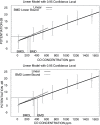Cumulative risk: toxicity and interactions of physical and chemical stressors
- PMID: 24154487
- PMCID: PMC3871930
- DOI: 10.1093/toxsci/kft228
Cumulative risk: toxicity and interactions of physical and chemical stressors
Abstract
Recent efforts to update cumulative risk assessment procedures to incorporate nonchemical stressors ranging from physical to psychosocial reflect increased interest in consideration of the totality of variables affecting human health and the growing desire to develop community-based risk assessment methods. A key roadblock is the uncertainty as to how nonchemical stressors behave in relationship to chemical stressors. Physical stressors offer a reasonable starting place for measuring the effects of nonchemical stressors and their modulation of chemical effects (and vice versa), as they clearly differ from chemical stressors; and "doses" of many physical stressors are more easily quantifiable than those of psychosocial stressors. There is a commonly held belief that virtually nothing is known about the impact of nonchemical stressors on chemically mediated toxicity or the joint impact of coexposure to chemical and nonchemical stressors. Although this is generally true, there are several instances where a substantial body of evidence exists. A workshop titled "Cumulative Risk: Toxicity and Interactions of Physical and Chemical Stressors" held at the 2013 Society of Toxicology Annual Meeting provided a forum for discussion of research addressing the toxicity of physical stressors and what is known about their interactions with chemical stressors, both in terms of exposure and effects. Physical stressors including sunlight, heat, radiation, infectious disease, and noise were discussed in reference to identifying pathways of interaction with chemical stressors, data gaps, and suggestions for future incorporation into cumulative risk assessments.
Keywords: cumulative risk; infectious disease; joint action; noise.; nonchemical stressors; radiation; sunlight; temperature.
Figures

References
-
- Babisch W., Pershagen G., Selander J., Houthuijs D., Breugelmans O., Cadum E., Vigna-Taglianti F., Katsouyanni K., Haralabidis A. S., Dimakopoulou K., et al. (2013). Noise annoyance–a modifier of the association between noise level and cardiovascular health? Sci. Total Environ. 452-453, 50–57 - PubMed
-
- Boekelheide K. (2005). Mechanisms of toxic damage to spermatogenesis. J. Natl. Cancer Inst. Monogr. 34, 6–8 - PubMed
-
- Campion S. N., Houseman E. A., Sandrof M. A., Hensley J. B., Sui Y., Gaido K. W., Wu Z., Boekelheide K. (2010a). Suppression of radiation-induced testicular germ cell apoptosis by 2,5-hexanedione pretreatment. II. Gene array analysis reveals adaptive changes in cell cycle and cell death pathways. Toxicol. Sci. 117, 457–465 - PMC - PubMed
-
- Campion S. N., Houseman E. A., Sandrof M. A., Hensley J. B., Sui Y., Gaido K. W., Wu Z., Boekelheide K. (2010b). Suppression of radiation-induced testicular germ cell apoptosis by 2,5-hexanedione pretreatment. III. Candidate gene analysis identifies a role for fas in the attenuation of x-ray-induced apoptosis. Toxicol. Sci. 117, 466–474 - PMC - PubMed
Publication types
MeSH terms
Substances
Grants and funding
LinkOut - more resources
Full Text Sources
Other Literature Sources

